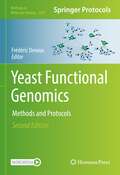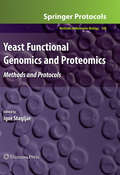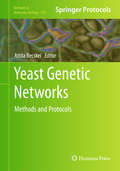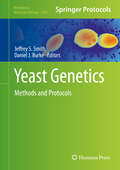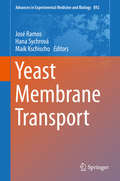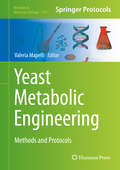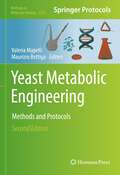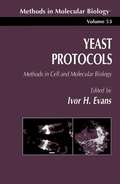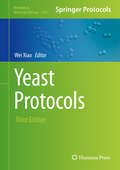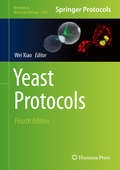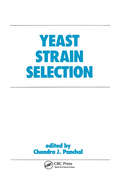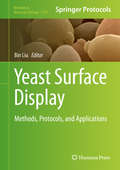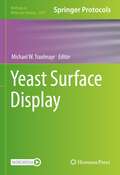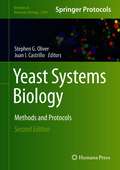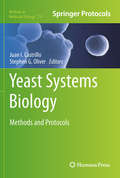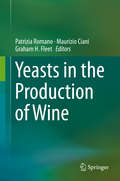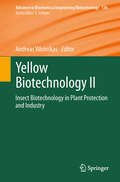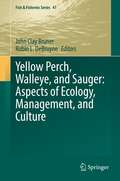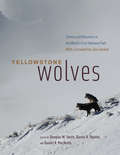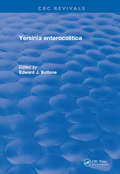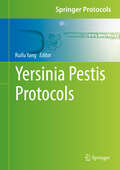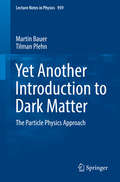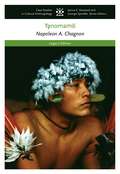- Table View
- List View
Yeast Functional Genomics: Methods and Protocols (Methods in Molecular Biology #2477)
by Frédéric DevauxThis second edition volume discusses the latest techniques and protocols used in the field that were not covered in the previous edition. The chapters in this book are organized into five parts. Part One looks at transcriptomic analyses and Part Two covers DNA replication and protein/DNA interactions. Part Three discusses translation dynamics, protein complexes, and proteomics. Part Four looks at genotypic screens and phenotypic profiling, and Part Five explores in silico integration of functional genomics data. Written in the highly successful Methods in Molecular Biology series format, chapters include introductions to their respective topics, lists of the necessary material and reagents, step-by-step, readily reproducible laboratory protocols, and tips on troubleshooting and avoiding known pitfalls.Cutting edge and practical, Yeast Functional Genomics: Methods and Protocols, Second Edition is a valuable resource for all researchers interested in learning more about the evolving field of yeast.Chapters 1, 9, 16, 20, 22, 24, and 25 are available open access under a Creative Commons Attribution 4.0 International License via link.springer.com.
Yeast Functional Genomics and Proteomics
by Igor StagljarGiven the popularity and utility of Saccharomyces cerevisiae, yeast-based functional genomics and proteomics technologies, developed over the past decade, have contributed greatly to our understanding of bacterial, yeast, fly, worm and human gene functions. In Yeast Functional Genomics and Proteomics: Methods and Protocols, experts in the field contribute stand-alone protocols suitable for daily use in research laboratories. The volume examines methods from the most major and fundamental techniques to more cutting-edge, advanced concepts. As part of the highly successful Methods in Molecular BiologyTM series, the chapters are clearly formatted with introductions to their respective topics, lists of the necessary materials and reagents, step-by-step, readily reproducible laboratory protocols, and notes on troubleshooting and avoiding known pitfalls. Authoritative and easy to use, Yeast Functional Genomics and Proteomics: Methods and Protocols is an ideal reference for both yeast researchers and those who wish to use yeast as a model system for the further study of functional genomics and proteomics.
Yeast Genetic Networks
by Attila BecskeiRegulation of gene expression, a major determinant of gene activity, occupies a central place in molecular biology. Yeast Genetic Networks: Methods and Protocols covers approaches to the systems biological analysis of small-scale gene networks in yeast. Divided into four convenient sections, this detailed volume discusses the methods used to analyze gene expression quantitatively, presents a collection of mathematical and computational tools to analyze stochasticity, adaptation, sensitivity in signal transmission, and oscillations in gene expression, provides instructional methods on how to utilize the tools of quantitative genetics to identify genes that regulate stochasticity and oscillations in gene expression, and concludes with a section devoted to the analysis of conserved gene expression systems and networks in different fungal species. Written in the highly successful Methods in Molecular BiologyTM series format, chapters contain introductions to their respective topics, lists of the necessary materials and reagents, step-by-step, readily reproducible laboratory protocols, and notes on troubleshooting and avoiding known pitfalls. Authoritative and accessible, Yeast Genetic Networks: Methods and Protocols serves as an ideal and valuable resource for both novices and experienced researchers.
Yeast Genetics
by Jeffrey S. Smith Daniel J. BurkeYeast Genetics: Methods and Protocols is a collection of methods to best study and manipulate Saccharomyces cerevisiae, a truly genetic powerhouse. The simple nature of a single cell eukaryotic organism, the relative ease of manipulating its genome and the ability to interchangeably exist in both haploid and diploid states have always made it an attractive model organism. Genes can be deleted, mutated, engineered and tagged at will. Saccharomyces cerevisiae has played a major role in the elucidation of multiple conserved cellular processes including MAP kinase signaling, splicing, transcription and many others. Written in the successful Methods in Molecular Biology series format, chapters include introductions to their respective topics, lists of the necessary materials and reagents, step-by-step, readily reproducible protocols and notes on troubleshooting and avoiding known pitfalls. Authoritative and easily accessible, Yeast Genetics: Methods and Protocols will provide a balanced blend of classic and more modern genetic methods relevant to a wide range of research areas and should be widely used as a reference in yeast labs.
Yeast Membrane Transport
by Maik Kschischo Hana Sychrová José RamosThis contributed volume reviews the recent progress in our understanding of membrane transport in yeast including both Saccharomyces cerevisiae and non-conventional yeasts. The articles provide a summary of the key transport processes and put these in a systems biology context of cellular regulation, signal reception and homeostasis. After a general introduction, readers will find review articles covering the mechanisms and regulation of transport for various substrates ranging from diverse nutrients to cations, water and protons. These articles are complemented by a chapter on extremophilic yeast, a chapter on the mathematical modelling of ion transport and two chapters on the role of transport in pathogenic yeasts and antifungal drug resistance. Each article provides both a general overview of the main transport characteristics of a specific substrate or group of substrates and the unique details that only an expert working in the field is able to transmit to the reader. Researchers and students of the topic will find this book to be a useful resource for membrane transport in yeast collecting information in one complete volume, which is otherwise scattered across many papers. This might also be interesting for scientists investigating other species in order to compare transport mechanisms with known functions in yeast with the cells on which they work.
Yeast Metabolic Engineering
by Valeria MapelliYeast Metabolic Engineering: Methods and Protocols provides the widely established basic tools used in yeast metabolic engineering, while describing in deeper detail novel and innovative methods that have valuable potential to improve metabolic engineering strategies in industrial biotechnology applications. Beginning with an extensive section on molecular tools and technology for yeast engineering, this detailed volume is not limited to methods for Saccharomyces cerevisiae, but describes tools and protocols for engineering other yeasts of biotechnological interest, such as Pichia pastoris, Hansenula polymorpha and Zygosaccharomyces bailii. Tools and technologies for the investigation and determination of yeast metabolic features are described in detail as well as metabolic models and their application for yeast metabolic engineering, while a chapter describing patenting and regulations with a special glance at yeast biotechnology closes the volume Written in the highly successful Methods in Molecular Biology series format, most chapters include an introduction to their respective topic, lists of the necessary materials and reagents, step-by-step, readily reproducible laboratory protocols and tips on troubleshooting and avoiding known pitfalls. Comprehensive and authoritative, Yeast Metabolic Engineering: Methods and Protocols aims to familiarize researchers with the current state of these vital and increasingly useful technologies.
Yeast Metabolic Engineering: Methods and Protocols (Methods in Molecular Biology #2513)
by Valeria Mapelli Maurizio BettigaThis second edition volume expands on the previous edition with new and updated chapters on the latest developments in the study of yeast within the biotechnology field. The chapters in this book cover topics such as transformation protocols for genetic engineering of Saccaromyces cerevisiae and Komagataella spp.; an overview of selection markers, promoters, and strains used for metabolic engineering of S. cerevisiae, P. pastoris, and Z. bailii; the use of yeast in CRISPR/Cas9 technology; tools to study metabolic pathway in Yarrowia lypolitica; and a discussion on the “universal expression system” that is applied in a broad spectrum of fungal species. Written in the highly successful Methods in Molecular Biology series format, chapters include introductions to their respective topics, lists of the necessary materials and reagents, step-by-step, readily reproducible laboratory protocols, and tips on troubleshooting and avoiding known pitfalls.Cutting-edge and authoritative, Yeast Metabolic Engineering: Methods and Protocols, Second Edition is a valuable resource for researchers and scientists interested in learning more about this important and developing field.
Yeast Protocols
by Ivor H. EvansYeast Protocols contains many key techniques for studying the biology of yeasts at both the cellular and molecular levels. Working primarily from Saccharomyces cerevisiae, the expert contributors explain step-by-step how to successfully isolate, identify, and culture yeasts; the secrets of meiotic mapping; how to use PFGE in karyotyping and gene localization; the methods for purification and analysis of various cell components; and the construction and exploitation of genomic DNA clone banks. They also cover the latest methods for chromosome engineering, insertional mutagenesis by Ty elements, mRNA abundance and half-life measurements, the use of reporter gene systems, genotoxicity testing, and more. Yeast Protocols follows the widely applauded Humana Methods in Molecular Biology style: brief introductions putting the particular method in context, comprehensive lists of materials, cookbook style instructions, and troubleshooting notes to avoid common pitfalls and solve problems. The techniques can be used with confidence and success by both inexperienced newcomers and established researchers.
Yeast Protocols
by Wei XiaoIn this second edition of a widely used classic laboratory manual, leading experts utilize the tremendous progress and technological advances that have occurred to create a completely new collection of not only the major basic techniques, but also advanced protocols for yeast research and for using yeast as a host to study genes from other organisms. The authors provide detailed methods for the isolation of subcellular components-including organelles and macromolecules, for the basic cellular and molecular analysis specific for yeast cells, and for the creation of conditional mutant phenotypes that lend themselves to powerful genome manipulation. Additional protocols offer advanced approaches to study genetic interactions, DNA and chromatin metabolism, gene expression, as well as the foreign genes and gene products in yeast cells.
Yeast Protocols (Methods in Molecular Biology #2196)
by Wei XiaoThis fourth edition provides all new methods on yeast that have not been included in the past three editions. Divided in four parts, chapters guide readers through general applications for genetic manipulation in yeast cells, genome-wide studies, systematically rearrange the yeast chromosomes, and pathway methods. Written in the highly successful Methods in Molecular Biology series format, chapters include introductions to their respective topics, lists of the necessary materials and reagents, step-by-step, readily reproducible laboratory protocols, and tips on troubleshooting and avoiding known pitfalls. Authoritative and cutting-edge, Yeast Protocol, Fourth Edition aims to compliment previous editions while offering new tools for the yeast research community.
Yeast Strain Selection
by Chandra J. PanchalContributors from universities and food, pharmaceutical, and brewing companies detail the current state of yeast strain development and handling, highlighting advances in yeast selection for academic research, industry, and recombinant DNA technology. Featuring the use of Saccharomyces and other yea
Yeast Surface Display
by Bin LiuIn addition to research and discovery, yeast surface display technology has found applications in industrial processes such as biofuel production and environmental pollutant absorption and degradation. Yeast Surface Display: Methods, Protocols, and Applications guides readers through yeast surface antibody display library and antibody engineering, yeast surface display as a tool for protein engineering, yeast surface cDNA display library construction and applications, and yeast surface display in bioassay and industrial applications. Written in the highly successful Methods in Molecular Biology series format, chapters include introductions to their respective topics, lists of the necessary materials and reagents, step-by-step, readily reproducible laboratory protocols, and key tips on troubleshooting and avoiding known pitfalls. Concise and easy-to-use, Yeast Surface Display: Methods, Protocols, and Applications aims to help accelerate the work of protein chemists, antibody engineers, molecular and cell biologists, and industrial bioengineers.
Yeast Surface Display (Methods in Molecular Biology #2491)
by Michael W. TraxlmayrThis detailed volume explores a wide variety of applications of yeast surface display, an extensively used protein engineering technology. Beginning with detailed protocols for the construction and efficient selection/screening of yeast surface display libraries, as well as for the analysis of individual yeast-displayed protein variants, the book continues with protocols describing the selection of yeast surface display libraries for binding to mammalian cells or to extracellular matrix as well as protocols for a broad spectrum of specialized yeast surface display applications, demonstrating the versatility of this display platform. Written for the highly successful Methods in Molecular Biology series, chapters include introductions to their respective topics, lists of the necessary materials and reagents, step-by-step, readily reproducible methodologies, and tips on troubleshooting and avoiding known pitfalls. Authoritative and practical, Yeast Surface Display serves as a comprehensive resource that enables the implementation of this powerful and versatile technique in virtually any molecular biology laboratory, even in the absence of any prior yeast surface display experience.
Yeast Systems Biology: Methods and Protocols (Methods in Molecular Biology #2049)
by Juan I. Castrillo Stephen G. OliverThis second edition volume expands on the previous edition with a look at the latest advances in techniques to study yeast and its core set of interactions, modules, architectures, and network dynamics that are common in all eukaryotes. The chapters in this book are organized into Four Parts: Part One provides readers with an update on the development of novel experimental and computational approaches to yeast systems biology; Part Two explores high-throughput methods used to study yeast epigenome, transcriptome, proteome, and metabolome; Part Three talks about computational systems biology, and focuses on data management, dynamic modeling, constraint-based models of metabolic networks, and multi-level ‘omics data; while Part Four looks at experimental platforms that utilize yeast to model systemic human diseases such as Alzheimer’s and Parkinson’s diseases. Written in the highly successful Methods in Molecular Biology series format, chapters include introductions to their respective topics; lists of the necessary materials and reagents; step-by-step, readily reproducible laboratory protocols; and tips on troubleshooting and avoiding known pitfalls.Cutting-edge and comprehensive, Yeast System Biology: Methods and Protocols, Second Edition is a valuable tool for graduate students, post-doctoral researchers, and experts who are interested in learning about the latest developments in the study of yeast.
Yeast Systems Biology
by Juan I. Castrillo Stephen G. OliverSystems Biology aims at deciphering the genotype-phenotype relationships at the levels of genes, transcripts (RNAs), peptides, proteins, metabolites, and environmental factors participating in complex cellular networks in order to reveal the mechanisms and principles governing the behavior of complex biological systems. Yeast Systems Biology: Methods and Protocols presents an up-to-date view of the optimal characteristics of the yeast Saccharomyces cerevisiae as a model eukaryote, perspective on the latest experimental and computational techniques for systems biology studies, most of which were first designed for and validated in yeast, and selected examples of yeast systems biology studies and their applications in biotechnology and medicine. These experiments under controlled conditions can uncover the complexity and interplay of biological networks with their dynamics, basic principles of internal organization, and balanced orchestrated functions between organelles in direct interaction with the environment as well as the characterization of short and long-term effects of perturbations and dysregulation of networks that may illuminate the origin of complex human diseases. Written for the highly successful Methods in Molecular BiologyTM series, this volume contains the kind of detailed description and implementation advice that is crucial for getting optimal results. Practical and cutting-edge, Yeast Systems Biology: Methods and Protocols serves researchers interested in comprehensive systems biology strategies in well-defined model systems with specific objectives as well as a better knowledge of the latest post-genomic strategies at all 'omic levels and computational approaches towards analysis, integration, and modeling of biological systems, from single-celled organisms to higher eukaryotes.
Yeasts in the Production of Wine
by Patrizia Romano Maurizio Ciani Graham H. FleetIt is well established that certain strains of yeasts are suitable for transforming grape sugars into alcohol, while other yeast strains are not suitable for grape fermentations. Recent progress has clearly demonstrated that the sensory profile of a wine is characteristic of each vine cultivated, and the quality and technological characteristics of the final product varies considerably due to the strains which have performed and/or dominated the fermentation process. Because of their technological properties, wine yeast strains differ significantly in their fermentation performance and in their contribution to the final bouquet and quality of wine, such as useful enzymatic activities and production of secondary compounds related both to wine organoleptic quality and human health. The wine industry is greatly interested in wine yeast strains with a range of specialized properties, but as the expression of these properties differs with the type and style of wine to be made, the actual trend is in the use of selected strains, which are more appropriate to optimize grape quality. Additionally, wine quality can be influenced by the potential growth and activity of undesirable yeast species, considered spoilage yeasts, which cause sluggish and stuck fermentation and detrimental taste and aroma in the wine.
Yellow Biotechnology I
by Andreas VilcinskasUtility of Insects for Studying Human Pathogens and Evaluating New Antimicrobial Agents, by Yan Wang, De-Dong Li, Yuan-Ying Jiang and Eleftherios Mylonakis. Galleria Mellonella as a Model Host to Study Gut Microbe Homeostasis and Brain Infection by the Human Pathogen Listeria Monocytogenes, by Krishnendu Mukherjee, Ramya Raju, Rainer Fischer and Andreas Vilcinskas. Drosophila as a Model to Study Metabolic Disorders, by Julia Hoffmann, Renja Romey, Christine Fink and Thomas Roeder. The Fruit Fly Drosophila melanogaster as a Model for Aging Research, by Annely Brandt and Andreas Vilcinskas. Drosophila and the Hallmarks of Cancer, by Theodoulakis Christofi and Yiorgos Apidianakis. The red flour beetle Tribolium castaneum as a model to monitor food safety and functionality, by Stefanie Grünwald, Iris V. Adam, Ana-Maria Gurmai, Ludmila Bauer, Michael Boll, and Uwe Wenzel. Identification and Bioanalysis of Natural Products from Insect Symbionts and Pathogens, by Alexander O. Brachmann and Helge B. Bode. Antiparasitic Peptides, by Jette Pretzel, Franziska Mohring, Stefan Rahlfs and Katja Becker.
Yellow Perch, Walleye, and Sauger: Aspects of Ecology, Management, and Culture (Fish & Fisheries Series #41)
by John Clay Bruner Robin L. DeBruyneWalleye, one of the most sought-after species of freshwater sport fishes in North America, has demonstrated appreciable declines in their numbers from their original populations since the beginning of the 20th century. Similarly, Yellow Perch, once the most commonly caught sport fish and an important commercial species in North America, have also shown declines. Compiling up-to-date information on the biology and management of Walleye, Sauger, and Yellow Perch, including research on systematics, genetics, physiology, ecology, movement, population dynamics, culture, recent case histories, and management practices, will be of interest to managers, researchers, and students who deal with these important species, particularly in light of habitat alterations, population shifts, and other biotic and abiotic factors related to a changing climate.
Yellowstone Wolves: Science and Discovery in the World's First National Park (America's Animal Comebacks Ser.)
by Douglas W. Smith Daniel R. MacNulty Daniel R. StahlerIn 2020, it will have been twenty-five years since one of the greatest wildlife conservation and restoration achievements of the twentieth century took place: the reintroduction of wolves to the world’s first national park, Yellowstone. Eradicated after the park was established, then absent for seventy years, these iconic carnivores returned to Yellowstone in 1995 when the US government reversed its century-old policy of extermination and—despite some political and cultural opposition—began the reintroduction of forty-one wild wolves from Canada and northwest Montana. In the intervening decades, scientists have studied their myriad behaviors, from predation to mating to wolf pup play, building a one-of-a-kind field study that has both allowed us to witness how the arrival of top predators can change an entire ecosystem and provided a critical window into impacts on prey, pack composition, and much else. Here, for the first time in a single book, is the incredible story of the wolves’ return to Yellowstone National Park as told by the very people responsible for their reintroduction, study, and management. Anchored in what we have learned from Yellowstone, highlighting the unique blend of research techniques that have given us this knowledge, and addressing the major issues that wolves still face today, this book is as wide-ranging and awe-inspiring as the Yellowstone restoration effort itself. We learn about individual wolves, population dynamics, wolf-prey relationships, genetics, disease, management and policy, newly studied behaviors and interactions with other species, and the rippling ecosystem effects wolves have had on Yellowstone’s wild and rare landscape. Perhaps most importantly of all, the book also offers solutions to ongoing controversies and debates. Featuring a foreword by Jane Goodall, beautiful images, a companion online documentary by celebrated filmmaker Bob Landis, and contributions from more than seventy wolf and wildlife conservation luminaries from Yellowstone and around the world, Yellowstone Wolves is a gripping, accessible celebration of the extraordinary Yellowstone Wolf Project—and of the park through which these majestic and important creatures once again roam.
Yellowstone's Wildlife in Transition
by P. J. White Robert A. Garrott Glenn E. PlumbThe world's first national park is constantly changing. How we understand and respond to recent events putting species under stress will determine the future of ecosystems millions of years in the making. Marshaling expertise from over 30 contributors, Yellowstone's Wildlife in Transition examines three primary challenges to the park's ecology.
Yersinia Enterocolitica
by Edward J. BottoneFirst published in 1981. Comprehensive overview of existing knowledge of Yersina enterocolitica, including laboratory models, clinical observations, and associated dieases.
Yersinia Pestis Protocols (Springer Series in Translational Stroke Research)
by Ruifu YangThis protocol book includes common and advanced research protocols for Yersinia pestis research and for its identification, genotyping and source-tracing. This book includes protocols for genomic and transcriptomic analysis, small RNA study, protein-protein interaction, gene deletion. It will be helpful for graduate students, clinicians, and researchers in infectious diseases, systems biology, and evolution and numerous other relevant fields.
Yet Another Introduction to Dark Matter: The Particle Physics Approach (Lecture Notes in Physics #959)
by Martin Bauer Tilman PlehnDark matter is a frequently discussed topic in contemporary particle physics. Written strictly in the language of particle physics and quantum field theory, these course-based lecture notes focus on a set of standard calculations that students need in order to understand weakly interacting dark matter candidates. After introducing some general features of these dark matter agents and their main competitors, the Higgs portal scalar and supersymmetric neutralinos are introduced as our default models. In turn, this serves as a basis for exploring four experimental aspects: the dark matter relic density extracted from the cosmic microwave background; indirect detection including the Fermi galactic center excess; direct detection; and collider searches. Alternative approaches, like an effective theory of dark matter and simplified models, naturally follow from the discussions of these four experimental directions.
Yąnomamö (Sixth Edition: The Legacy Edition) (Case Studies in Cultural Anthropology Series)
by Napoleon A. ChagnonThe Yanomamo of Venezuela and Brazil are a truly remarkable people, and one of the few sovereign tribal societies left on earth. This classic ethnography, based on the authors extensive fieldwork, includes a brief discussion of events and changes that have occurred since 1996. The Legacy 6th Edition of The Yanomamo also includes a Q&A interview with the author, which reveals his own perspective on his life's work, reflects changes within the field of anthropology itself, and presents the authors views on the recent decade of controversies that his work has inspired among critics (including some anthropologists).
